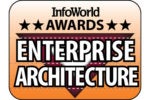Molina Healthcare: Realigning around business outcomes
Molina Healthcare is a Fortune 500 company that must meet stringent regulatory health care requirements. The EA group at Molina Healthcare is a lean business unit within the office of the CTO. Established in 2011, EA is an eight-member team of enterprise, information, and solution architects that works with senior stakeholders that lead business units and strategic projects across the organization.
Rechartering EA for business outcomes involved sweeping changes. The primary driver was the need to evolve the EA unit from a technology-centric, top-down, "policing" type of operation to one focused on business goals -- and the ability to collaborate with internal partners to ensure strategic goals are realized.
A key requirement was the need to support an overarching governance initiative that stressed the importance of technology reuse, while providing greater assurance that Molina Healthcare would make the best decisions based on sound business information drawn from across the enterprise. EA responded with a strategy that simplified its own service offering, narrowed its focus, and fundamentally redefined how it needed to fit within the organization. This strategy has enabled EA to provide strategic direction and support executive decision in four key areas:
- Business planning: Describing the business and how IT aligns with it to reduce project risk
- Project portfolio management: Knowing when and how to engage EA in projects to improve quality
- Operational management: Reigning in costs by assessing proposed new technologies earlier in the procurement cycle and increasing portfolio/asset reuse
- Solution development: Controlling distributed technology to improve service delivery
As a result, EA now enjoys a dramatically different role within Molina Healthcare. By fine-tuning and simplifying its service offering -- and organizing the EA team around deliverables that benefit the organization rather than simply meeting IT objectives -- EA has become a strategic partner that enables better decisions and greater reuse across the enterprise.
Evolving from an operationally focused unit that primarily drove IT projects to a strategic resource was a significant organizational challenge. There was ambiguity around the specific role of enterprise architects versus other architects in the organization. This, along with a tactical focus, contributed to suboptimal utilization of enterprise architects. For example, EA would typically conduct architectural reviews for projects too late in the procurement cycle to provide adequate assessment, leading to costly technology duplication.
To address these challenges, EA opted for a "partnership" approach with the project management office in particular, a key entry point for new technologies. EA also simplified its own business processes to make the EA practice more approachable. For example, instead of administering a daunting 20-question “technology-focused“ project review form, EA now asks six simple business-focused questions.
In addition, the EA team trimmed services and became much more specific about what it could do to facilitate better decisions. These capabilities included: business direction through the use of capability maps, architectural direction using road maps, and structured direction using road maps that show an alignment of technologies that support capabilities. The team also promoted the adoption of enterprise-wide standards. An account manager role was introduced for core business capability areas, to ensure an in-depth understanding of each business unit and its needs.
As part of its rechartering efforts, EA also reorganized services around two primary clusters of enterprise architecture offerings: strategic services (focused on future-state planning, road-mapping, governance, and standard-setting) and tactical services (focused on new technology evaluation, solution design, and facilitation).
More important, all of EA's services now directly support a global governance initiative:
- Architecture governance: EA evaluates architectural quality against several criteria, including business alignment, compliance, and interoperability.
- Data governance: EA ensures new technologies are identified and all handoffs support data governance initiatives.
- Project governance: EA participates in project intake sessions, facilitates discussions around strategic projects, and ensures EA involvement in strategic projects at different levels as required.
- Standards governance: EA supports routine application portfolio reviews, reviews newly procured software, simplifies IT investment decisions, and accelerates system implementation.
- Technology portfolio governance: EA evaluates new technology against several criteria, including cost management, reuse, and standards adherence.
Collectively, these efforts have resulted in a streamlined, collaborative approach that has enabled EA to evaluate projects sooner and determine where EA architects need to step in to identify new technologies. By partnering with stakeholders in each business area, EA now ensures that the company no longer invests in one-off, parochial technology solutions that favor a particular business unit or project. All initiatives, including ad-hoc IT efforts, have clearly stated objectives, be they new capabilities or new business functions that improve quality or remove barriers to health care services.









